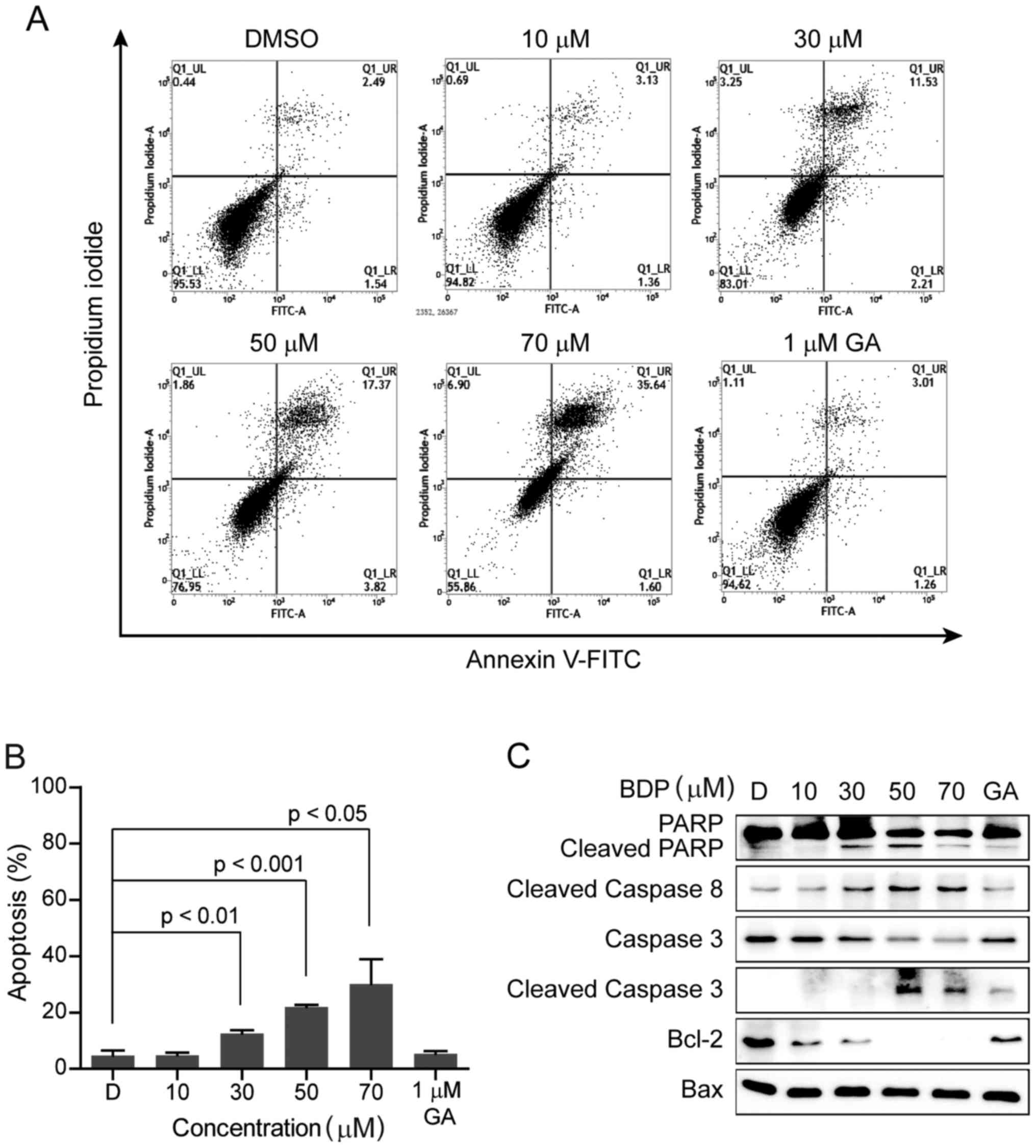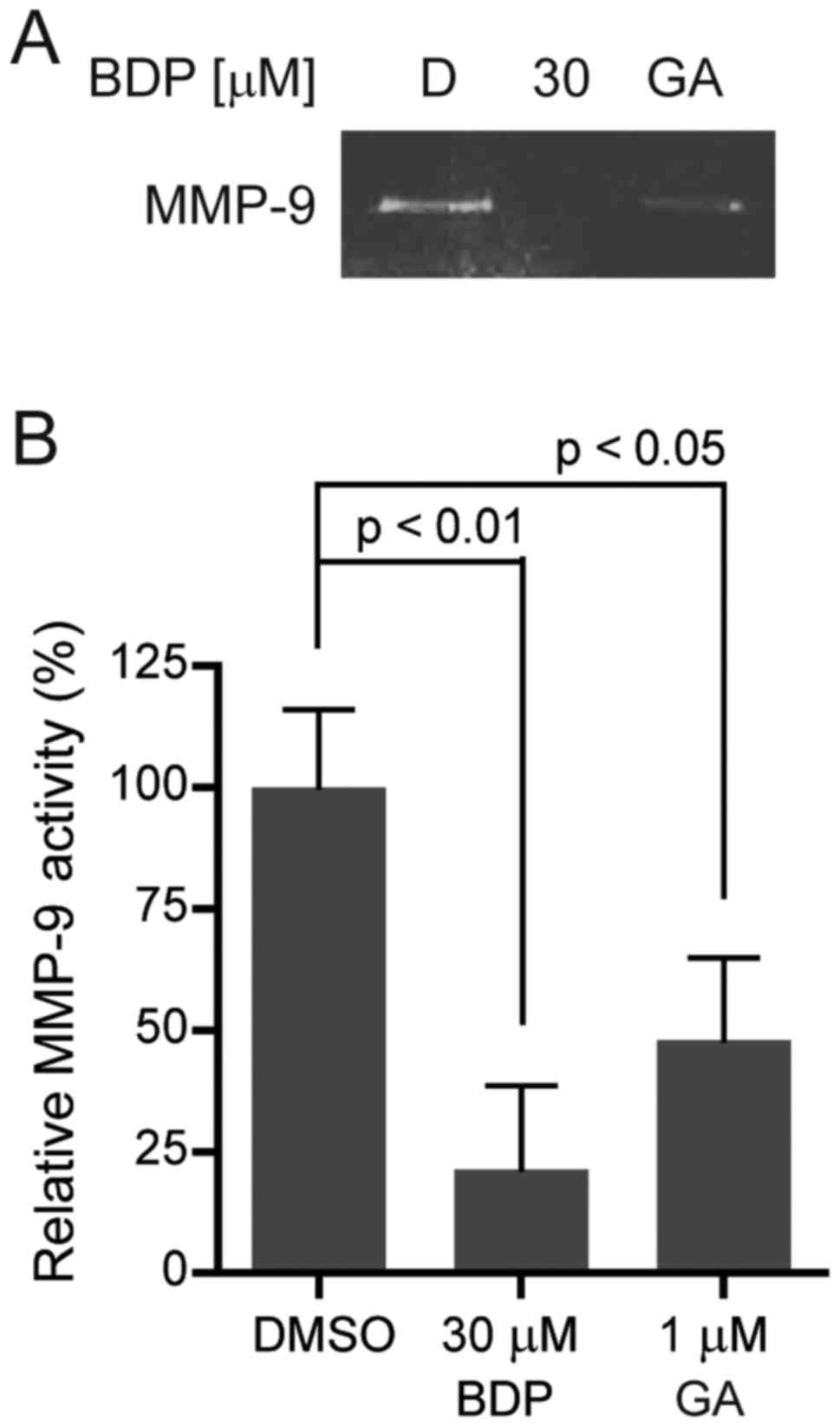|
1
|
Anders C and Carey LA: Understanding and
treating triple-negative breast cancer. Oncology (Williston Park).
22:1233–1239; discussion 1239–1240, 1243. 2008.PubMed/NCBI
|
|
2
|
Osborne CK and Schiff R: Mechanisms of
endocrine resistance in breast cancer. Annu Rev Med. 62:233–247.
2011. View Article : Google Scholar : PubMed/NCBI
|
|
3
|
Baselga J: Targeting the
phosphoinositide-3 (PI3) kinase pathway in breast cancer.
Oncologist. 16 Suppl 1:12–19. 2011. View Article : Google Scholar : PubMed/NCBI
|
|
4
|
Gradishar WJ, Anderson BO, Balassanian R,
Blair SL, Burstein HJ, Cyr A, Elias AD, Farrar WB, Forero A,
Giordano SH, et al: NCCN Guidelines Insights Breast Cancer, Version
1.2016. J Natl Compr Canc Netw. 13:1475–1485. 2015. View Article : Google Scholar : PubMed/NCBI
|
|
5
|
Haffty BG, Yang Q, Reiss M, Kearney T,
Higgins SA, Weidhaas J, Harris L, Hait W and Toppmeyer D:
Locoregional relapse and distant metastasis in conservatively
managed triple negative early-stage breast cancer. J Clin Oncol.
24:5652–5657. 2006. View Article : Google Scholar : PubMed/NCBI
|
|
6
|
Cheng Q, Chang JT, Geradts J, Neckers LM,
Haystead T, Spector NL and Lyerly HK: Amplification and high-level
expression of heat shock protein 90 marks aggressive phenotypes of
human epidermal growth factor receptor 2 negative breast cancer.
Breast Cancer Res. 14:R622012. View
Article : Google Scholar : PubMed/NCBI
|
|
7
|
Dent R, Trudeau M, Pritchard KI, Hanna WM,
Kahn HK, Sawka CA, Lickley LA, Rawlinson E, Sun P and Narod SA:
Triple-negative breast cancer: Clinical features and patterns of
recurrence. Clin Cancer Res. 13:4429–4434. 2007. View Article : Google Scholar : PubMed/NCBI
|
|
8
|
Sankhala KK, Mita MM, Mita AC and Takimoto
CH: Heat shock proteins: A potential anticancer target. Curr Drug
Targets. 12:2001–2008. 2011. View Article : Google Scholar : PubMed/NCBI
|
|
9
|
Bishop SC, Burlison JA and Blagg BS:
Hsp90: A novel target for the disruption of multiple signaling
cascades. Curr Cancer Drug Targets. 7:369–388. 2007. View Article : Google Scholar : PubMed/NCBI
|
|
10
|
Zuehlke A and Johnson JL: Hsp90 and
co-chaperones twist the functions of diverse client proteins.
Biopolymers. 93:211–217. 2010. View Article : Google Scholar : PubMed/NCBI
|
|
11
|
Mahalingam D, Swords R, Carew JS, Nawrocki
ST, Bhalla K and Giles FJ: Targeting HSP90 for cancer therapy. Br J
Cancer. 100:1523–1529. 2009. View Article : Google Scholar : PubMed/NCBI
|
|
12
|
Hanahan D and Weinberg RA: The hallmarks
of cancer. Cell. 100:57–70. 2000. View Article : Google Scholar : PubMed/NCBI
|
|
13
|
Hanahan D and Weinberg RA: Hallmarks of
cancer: The next generation. Cell. 144:646–674. 2011. View Article : Google Scholar : PubMed/NCBI
|
|
14
|
Normant E, Paez G, West KA, Lim AR, Slocum
KL, Tunkey C, McDougall J, Wylie AA, Robison K, Caliri K, et al:
The Hsp90 inhibitor IPI-504 rapidly lowers EML4-ALK levels and
induces tumor regression in ALK-driven NSCLC models. Oncogene.
30:2581–2586. 2011. View Article : Google Scholar : PubMed/NCBI
|
|
15
|
Mishra L, Sinha R, Itokawa H, Bastow KF,
Tachibana Y, Nakanishi Y, Kilgore N and Lee KH: Anti-HIV and
cytotoxic activities of Ru(II)/Ru(III) polypyridyl complexes
containing 2,6-(2′-benzimidazolyl)-pyridine/chalcone as co-ligand.
Bioorg Med Chem. 9:1667–1671. 2001. View Article : Google Scholar : PubMed/NCBI
|
|
16
|
Chen M, Christensen Brøgger S, Zhai L,
Rasmussen MH, Theander TG, Frøkjaer S, Steffansen B, Davidsen J and
Kharazmi A: The novel oxygenated chalcone,
2,4-dimethoxy-4′-butoxychalcone, exhibits potent activity against
human malaria parasite Plasmodium falciparum in vitro and rodent
parasites Plasmodium berghei and Plasmodium yoelii in vivo. J
Infect Dis. 176:1327–1333. 1997. View
Article : Google Scholar : PubMed/NCBI
|
|
17
|
Ducki S: The development of chalcones as
promising anticancer agents. IDrugs. 10:42–46. 2007.PubMed/NCBI
|
|
18
|
Chua AW, Hay HS, Rajendran P, Shanmugam
MK, Li F, Bist P, Koay ES, Lim LH, Kumar AP and Sethi G: Butein
downregulates chemokine receptor CXCR4 expression and function
through suppression of NF-κB activation in breast and pancreatic
tumor cells. Biochem Pharmacol. 80:1553–1562. 2010. View Article : Google Scholar : PubMed/NCBI
|
|
19
|
Katsori AM and Hadjipavlou-Litina D:
Chalcones in cancer: Understanding their role in terms of QSAR.
Curr Med Chem. 16:1062–1081. 2009. View Article : Google Scholar : PubMed/NCBI
|
|
20
|
Liu X and Go ML: Antiproliferative
properties of piperidinylchalcones. Bioorg Med Chem. 14:153–163.
2006. View Article : Google Scholar : PubMed/NCBI
|
|
21
|
Modzelewska A, Pettit C, Achanta G,
Davidson NE, Huang P and Khan SR: Anticancer activities of novel
chalcone and bis-chalcone derivatives. Bioorg Med Chem.
14:3491–3495. 2006. View Article : Google Scholar : PubMed/NCBI
|
|
22
|
Jeong JH, Oh YJ, Kwon TK and Seo YH:
Chalcone-templated Hsp90 inhibitors and their effects on gefitinib
resistance in non-small cell lung cancer (NSCLC). Arch Pharm Res.
40:96–105. 2017. View Article : Google Scholar : PubMed/NCBI
|
|
23
|
Jeong JH, Oh YJ, Lho Y, Park SY, Liu KH,
Ha E and Seo YH: Targeting the entry region of Hsp90's ATP binding
pocket with a novel 6,7-dihydrothieno[3,2-c]pyridin-5(4H)-yl amide.
Eur J Med Chem. 124:1069–1080. 2016. View Article : Google Scholar : PubMed/NCBI
|
|
24
|
Jeong CH, Park HB, Jang WJ, Jung SH and
Seo YH: Discovery of hybrid Hsp90 inhibitors and their
anti-neoplastic effects against gefitinib-resistant non-small cell
lung cancer (NSCLC). Bioorg Med Chem Lett. 24:224–227. 2014.
View Article : Google Scholar : PubMed/NCBI
|
|
25
|
Lee T and Seo YH: Targeting the
hydrophobic region of Hsp90's ATP binding pocket with novel
1,3,5-triazines. Bioorg Med Chem Lett. 23:6427–6431. 2013.
View Article : Google Scholar : PubMed/NCBI
|
|
26
|
Seo YH and Jeong JH: Synthesis of butein
analogues and their anti-proliferative activity against
gefitinib-resistant non-small cell lung cancer (NSCLC) through
Hsp90 inhibition. Bull Korean Chem Soc. 35:1294–1298. 2014.
View Article : Google Scholar
|
|
27
|
Chacón RD and Costanzo MV: Triple-negative
breast cancer. Breast Cancer Res. 12 Suppl 2:S32010. View Article : Google Scholar
|
|
28
|
Elias AD: Triple-negative breast cancer: A
short review. Am J Clin Oncol. 33:637–645. 2010. View Article : Google Scholar : PubMed/NCBI
|
|
29
|
Hudis CA and Gianni L: Triple-negative
breast cancer: An unmet medical need. Oncologist. 16 Suppl 1:1–11.
2011. View Article : Google Scholar : PubMed/NCBI
|
|
30
|
Andreopoulou E, Schweber SJ, Sparano JA
and McDaid HM: Therapies for triple negative breast cancer. Expert
Opin Pharmacother. 16:983–998. 2015. View Article : Google Scholar : PubMed/NCBI
|
|
31
|
Sidera K and Patsavoudi E: Extracellular
HSP90: Conquering the cell surface. Cell Cycle. 7:1564–1568. 2008.
View Article : Google Scholar : PubMed/NCBI
|
|
32
|
Sekihara K, Harashima N, Tongu M, Tamaki
Y, Uchida N, Inomata T and Harada M: Pifithrin-μ, an inhibitor of
heat-shock protein 70, can increase the antitumor effects of
hyperthermia against human prostate cancer cells. PLoS One.
8:e787722013. View Article : Google Scholar : PubMed/NCBI
|
|
33
|
Banerji U, O'Donnell A, Scurr M, Pacey S,
Stapleton S, Asad Y, Simmons L, Maloney A, Raynaud F, Campbell M,
et al: Phase I pharmacokinetic and pharmacodynamic study of
17-allylamino, 17-demethoxygeldanamycin in patients with advanced
malignancies. J Clin Oncol. 23:4152–4161. 2005. View Article : Google Scholar : PubMed/NCBI
|
|
34
|
Viktorsson K, Lewensohn R and Zhivotovsky
B: Apoptotic pathways and therapy resistance in human malignancies.
Adv Cancer Res. 94:143–196. 2005. View Article : Google Scholar : PubMed/NCBI
|
|
35
|
Jiang X and Wang X: Cytochrome
C-mediated apoptosis. Annu Rev Biochem. 73:87–106. 2004.
View Article : Google Scholar : PubMed/NCBI
|
|
36
|
Tseng LM, Hsu NC, Chen SC, Lu YS, Lin CH,
Chang DY, Li H, Lin YC, Chang HK, Chao TC, et al: Distant
metastasis in triple-negative breast cancer. Neoplasma. 60:290–294.
2013. View Article : Google Scholar : PubMed/NCBI
|
|
37
|
Trinca F, Inacio M, Timoteo T and Dinis R:
Triple-negative breast cancer with brain metastasis in a pregnant
woman. BMJ Case Rep 20172017. doi:10.1136/bcr-2016-218657.
|
















